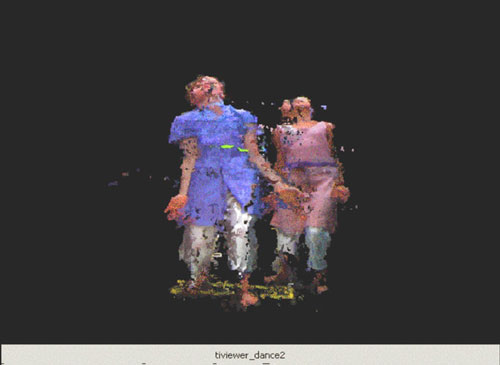We conducted a public dance performance in December 20069 where the dancers at UIUC and UCB laboratories danced jointly in cyberspace, and the jointly rendered visual performance was then transmitted to the lobby of the Hearst Mining Building at UCB for an audience to watch. We began the planning of the collaborative dance experiment with the hypothesis that dance is a form of communication, even if it is conducted in cyberspace. Hence, we posed many questions prior to the performance, and we will elaborate on some of them: (1) How do we create meaning with movement in cyberspace? (2) Is the meaning of dance the same for the audience when seeing physical dancers and virtual dancers? (3) Is the choreography the same when dancing in physical space, in virtual space, and in hybrid spaces? Before we provide answers to our questions, we will describe the dancing experimental setup and additional TI technological setup for the performance.
Dancing Experimental Setup: During the experiment, the overall dance choreography consisted of four components:
- The choreography included live dancers dancing in the physical space of the Hearst Mining Building lobby at UC Berkeley;
- A small group of dancers from UCB danced physically in the UCB TI laboratory (TI studio) on the 4th floor in the Hearst Mining Building, using the 3D TI virtual space technology, to become virtual dancers in cyberspace.
- One dancer performing physically in UIUC TI laboratory (TI studio) entered the common virtual space of the UCB virtual dancers and danced in synchrony with the UCB dancers.
- The integrated joint 3D Virtual Space and the overall performance were projected on large screens in both geographic sites, i.e., in the Hearst Mining lobby at UCB and in the atrium/conference room at UIUC.9
Figure 5 shows an image of two dancers rendered and shown together during the performance. Both dancers are first in the UCB TI Lab before being joined by a third dancer from UIUC in cyberspace. The performance started with dance segments in cyberspace where the geographically distributed dancers presented, in a synchronized fashion, different types of movements, including meeting, chatting, and hugging in cyberspace; collaborative rowing of a boat; use of standard improvisation scores such as mirroring; following a leader; creating foreground and background visual information; use of contact or virtual contact; and many other movements natural in physical spaces but very different in cyberspace. Once the dance in cyberspace finished, the live dancers continued with their dance choreography in the physical space.

TI Technological Experimental Setup: Before the public performance, we had to perform geometric, photometric calibration at both sites in order to assure that colors, the size of performers and the space was coordinated and looked realistic. Once the performance started, our TI protocols transmitted 3D streams between UCB and UIUC to provide a synchronous virtual space at both sites. In addition to the Common Virtual Space, we had voice communication (Voice over IP) on both sites, which was necessary for the dance coordination and synchronization. The music to which the performers were dancing was shared, the beginning of the music playback was synchronized after the initial synchronization, and the playback was executed locally in order to avoid any delays. At the UIUC site, we had also enabled 2D web cameras to show the live studio scenes in the UCB and UIUC TI studios.
Audience Feedback: The audience received questionnaires to share with us their overall perception. The overall feedback was positive, since the networking performance of the dance in cyberspace was very stable and robust for the 40 minute performance duration. The dancers danced in a synchronized fashion, which validated our 3D real-time vision and networking approaches. The TI system streamed the data well compared to the web camera. The strong time synchronized performance of our system was especially visible when contrasted with the web cameras, which showed a delay of several seconds when delivering the real TI studio scenes. The audience understood that without our TI solutions, i.e., if we used only web cameras, (a) the dancers would not be able to dance in collaborative fashion, (b) the dancers would not be able to be rendered into a common, joint virtual space, and (c) the dancers would not be able to experiment with movements as they are used to on a real stage. In TI virtual space, the dancers were able to create a very pleasing set of movements that were truly enjoyable to watch.






